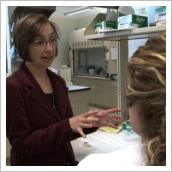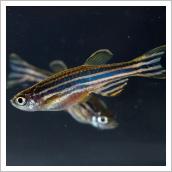by Sarah Geegan
Biology Professor Ann Morris' lab contains approximately 200 individual fish tanks, but only one type of fish.
Having recently secured a $1 million grant from the National Institutes of Health (NIH), Morris will continue investigating zebrafish and the insight they offer in regard to solutions for human retinal degeneration. The NIH grant, titled, “The role of insm1 in vertebrate photoreceptor differentiation,” will be funded over five years and focuses on zebrafish to better understand genetic pathways that control the development of the retina.
"Mammals cannot regenerate photoreceptors, because the retina is part of the central nervous system, and like other neurons in the brain, when you damage them you can't replace them," Morris said. "So that means when people get genetic diseases where the neurons, particularly the photoreceptors, start to die or to degenerate, there's no way of replacing those cells, so eventually they go blind. While that's true for mammals, it's not true for fish. Fish can regenerate photoreceptors."
Morris' study focuses on both the development of the retina and photoreceptor regeneration in fish, as she hopes to gain insight that could eventually be applied to the development of cell-based therapies for human retinal regeneration.
 "One reason that we can do this, say that what we learn about fish will help humans, is because the structure of the retina and types of cells that you find there are very well conserved between fish and humans," Morris said. "That means that throughout evolution in all of the vertebrates, to which fish and humans both belong, there is a very similar structure to the retina. The same types of cells are found in the retina and the same types of genes control its development in both species. So what we learn in a fish can potentially be applied to what we know about humans."
"One reason that we can do this, say that what we learn about fish will help humans, is because the structure of the retina and types of cells that you find there are very well conserved between fish and humans," Morris said. "That means that throughout evolution in all of the vertebrates, to which fish and humans both belong, there is a very similar structure to the retina. The same types of cells are found in the retina and the same types of genes control its development in both species. So what we learn in a fish can potentially be applied to what we know about humans."
Morris began her work with photoreceptor cells in fish before coming to UK. Using a technique called gene expression profiling, she identified a list of genes to investigate in regard to their role in photoreceptor regeneration. Once at UK, she and her students began working through this list to determine which genes were influential in the production of photoreceptors.
"We are particularly focusing on a gene named 'insulinoma-associated 1,' or insm1," Morris said. "We have recently shown that it plays a role in photoreceptor developments, and this grant will allow us to investigate it's precise function further and to learn more about all the genes regulated by Insm1 that are also required in making photoreceptors."
The grant will also allow Morris, in collaboration with a lab at Northwestern University, to extend the study to mice and determine if insm1 is interacting with the same genes to make mouse photoreceptors. This would bring the study one step closer to human implications, because mice are also mammals.
Morris said that both graduate and undergraduate students will have opportunities to conduct this research. Her lab currently hosts four graduate students, one of whom primarily focuses on this specific study. Each semester, undergraduate students also have the option to gain elective research credit through projects in the lab, working closely with the graduate students.
"I think it is important to stress that this work is not just mine, and that what we do is very much a team-based approach," Morris said. "My professional success is really interdependent with that of my graduate students and the other people in the lab. I may generate the ideas or come up with an overall research plan, but it is actually in very large part the graduate students and the undergraduate students as they work with the technicians in the lab who are actually doing most of the actual research."
The funding period began on Aug. 1, 2012. Morris said she is very excited to see the findings that her lab unveils.


